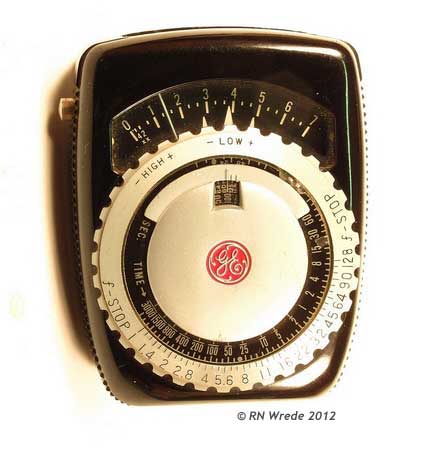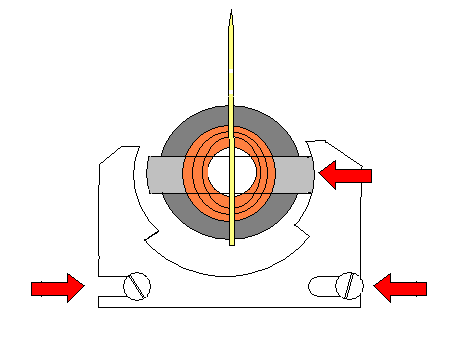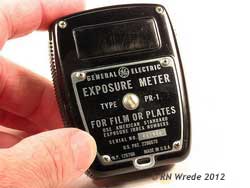GE EXPOSURE METER TYPE PR-1THE METER: I recently got a great deal at an estate sale when I got this 'General Electric Exposure Meter Type PR-1' from the late 1940's to early 1950's for $2.50! I didn't care if it worked or not, the case is near mint, or as close to it as you can get for something 60 years old. I'm talking just one tiny blemish on the main name plate on the back and the bakelite case looks like it's only been used for a couple times out. The needle though, had no response so I was hoping it was the type that took batteries. If not, no biggie, it's a cool collection piece. I got home and looked it up, shoot, no battery needed. I got curious so I opened up the back and noticed the outside magnet was shoved up against the galvanometer. I drew a crude diagram in MS Paint to show what I did.
Above: the top red arrow shows the magnet shoved over to the left against the needle galvanometer. It must have been dropped but the case shows no damage from a drop. The bottom arrows show the screws I loosened to slide the magnet over. Below is after the fix.
Well it worked fine after that but the outer calculation dial wasn't turning quite how it was when I got it. This meter uses a High - Low "trident" pointer that lines up with the needle. When scaling from high light to low light (turning clockwise) the pointer disappears down on the right side and a new pointer pops up on the left side. Kinda cool, no, really cool. What I didn't know is, when you do this it also makes a flap in front between the lens and the selenium cell pop down for low light to expose more of the cell and up, covering most of the cell except for two holes in the flap. This meter is very accurate and is designed to be used in the darkroom as well so I assume the reason for the fully exposed cell in low light. When I put the thing back together I didn't get the arm connecting the pointer to this front flap in place correctly so I needed to tear it fully apart to see how it worked. I got it figured out but as I was putting it back together the galvanometer needle fell right out, the delicate little copper spring-like contacts looking like a couple tiny Slinky's. Ruined. When the magnet originally shoved against the galvanometer it knocked it off of it's axis. An above and below needle-pin in hole, the bottom pin was out. Shoot this thing was actually working even with it's axis pointer thingy's off kilter. That explains why the needle seemed loose and worked best if tilted to the right while using it, but none the less, it worked. This was very depressing to "fix" something this cool and to destroy it in the same breath. FIXES: Well after seeing this thing in action and having it actually work for an hour, I'm not complacent at it just being a mere shell of it's former self, even if I did originally buy it as a 'non working' yard sale find. I got one on eBay for a couple bucks that had a beat up looking case but is in working order and I swapped out the guts. just a few micro scratches on the back only visible in a reflection like above.
[Camera Home] [SLRs] [Rangefinders] [Viewfinders] [TLR] this site owned and maintained by R.Wrede,© all rights reserved. |




